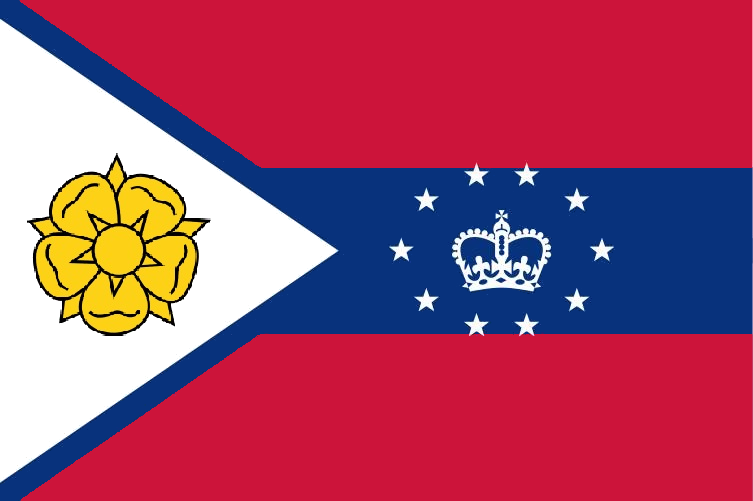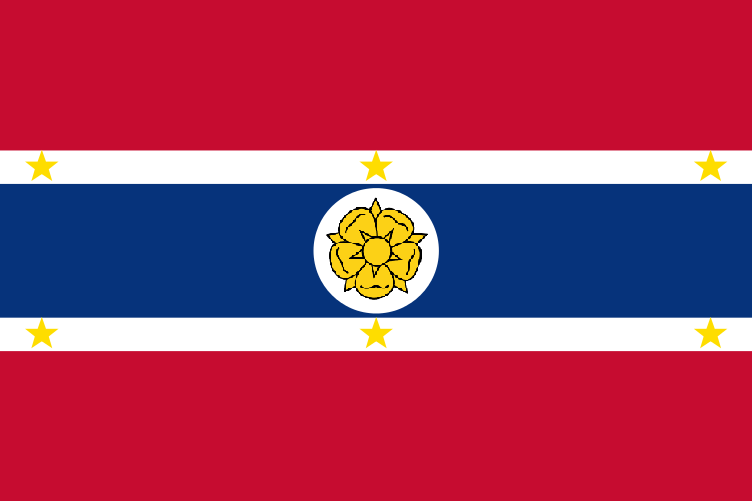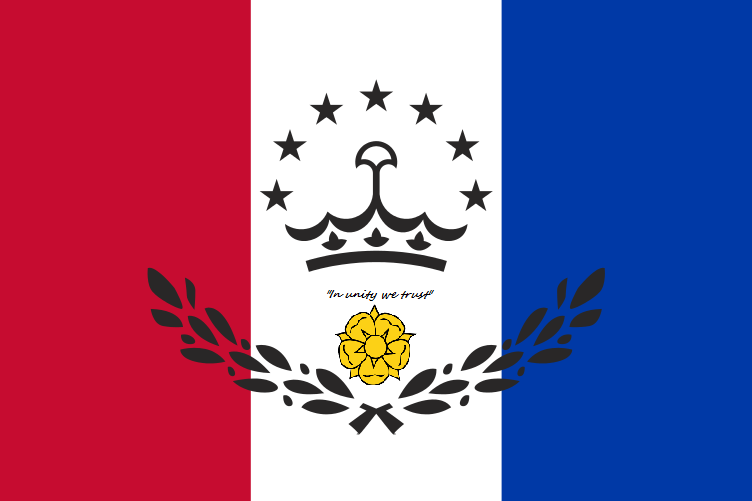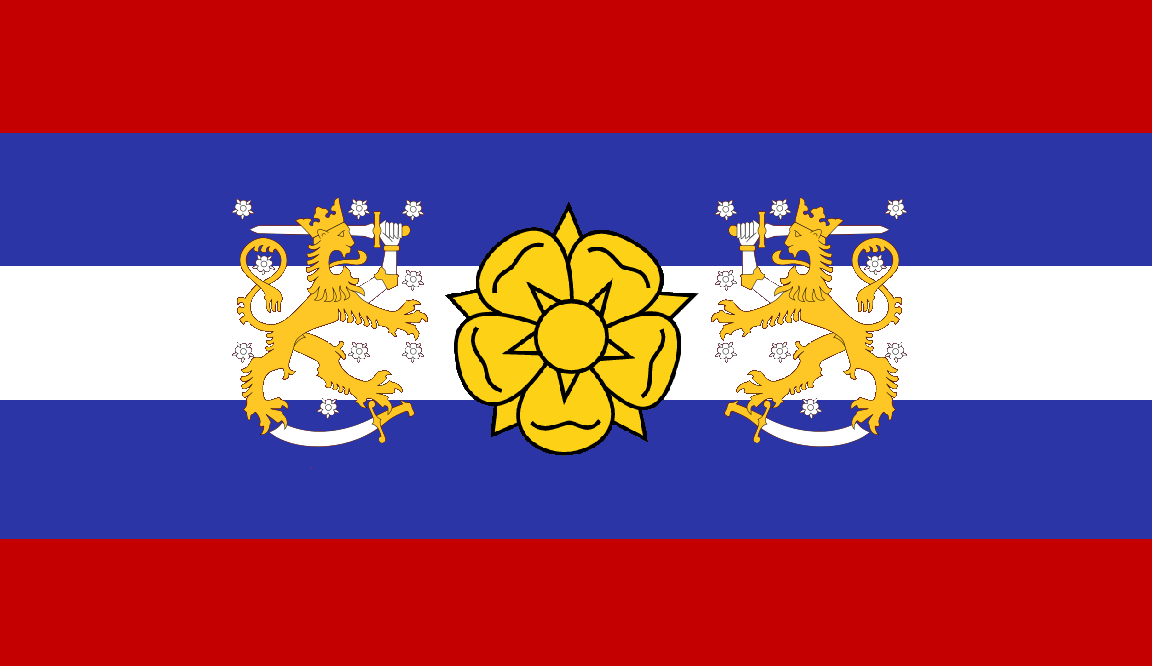History:
Before 1515:
Settlement by anatomically modern humans of what was to become the United Kingdom began around 100,000 years ago. During this period, the Strathepolic Ridge connected the continents of Aurora to Yasteria across the Caven Sea. In the next 50,000 years, the earliest known Auroran culture had developed and is thought to belonged, in the main, to a culture termed Strathepolic. Around 50,000 years ago, the ridge submerged as sea levels rose. The Strathepolic peoples, which had been settled along the ridge for thousands of years were forcibly isolated from one another, starting the early population of Aurora and the earliest known division of the two continents.
Union of the Thrones:
On the 29th of December 1515, the United Kingdom came into being, the result of the Battle for Caltharus 1515 which crowned Lambertus III King of Staynes and Caltharus.
Western Auroran Crusades:
Redrugus IX annexed the Kormistazmic Empire as a Principality during the Western Auroran Crusades, which lasted 52 years, from 1523 to 1575.
Colonialism:
Morstaybishlian colonialism began as early as 1444 when a Staynish expedition led by Wince Ledkeat under the command of Queen Serena saw the Necraties and Frorkstolm become extended territory. Both Frorkstolm and the Necraties were uninhabited and sought after for the development of trade outposts, which began less than two years after its discovery. Perdaé, the Necraties’ capital, began life as a port town until the late 16th century, where Lambertus V designated its port to be shared for naval affairs. It was first used for this purpose when it rallied galleons in 1604 to invade Justelvard.
Many species endemic to the Necratie Isles were pushed to extinction from the arrival of people and pests. Gold-tipped owls were a species of owl that was hunted for their feathers and rendered extinct in the wild in the latter of the 18th century. Despite persistent attempts to re-introduce the captive populations into the wild, the species was declared fully extinct in 1974.
The Necraties, Frorkstolm and the Staynish Pacific Territory saw a spur of piracy in the mid to late 16th to mid 19th centuries. Rebels and pirates saw the islands as perfect hiding places in the war against scum and villainy, as well as perfect areas to manoeuvre the pirating business to its greatest heights between 1660 and 1730. Pirates were a common pest in these waters until the navy sentenced the seven most notorious Caven Captains to death soon after the battle of Valna Bay which saw to their capture in 1821. Continuous efforts by the navies of the southern Yasterian and north Auroran nations saw to the eventual demise of pirates in and around the Caven Sea.
Morsto-Justelvardic War:
The earliest record of Justelvard in Morstaybishlian history was a written document signed by Lambertus V on the 10th of January 1602, agreeing to install the necessary components for a full scale invasion and planned annexation of Justelvard and Kistelvard, which made up the Strathepole archipelago; and to greatly enlarge the size of the standing Morstaybishlian Army to defend the ever-expanding Auroran empire. In the latter of the same month, a letter left Fort Staynes on horseback and arrived in Fort Jubrayn on the 5th of February the same year to Francesci Morston, the then current Military Overseer. The script, which was reportedly burnt soon thereafter, demanded the production of one hundred ships-of-the-line and a million trained soldiers in two years.
In January 1603, Lambertus V received an imperative tactical map from a Jussie called Dorghold. The drawing showed relevant information such as towns, docks, ships and more. The meeting concluded with the promise to allow Dorghold some undisclosed form of power of his homeland after the war. (tbc)
Pax-Morsto Superstate:
In 1897, Thadeus I married Zerah Demir IV, Princess of the Caliphate. The two superpowers were united under marriage and for 20 years remained so, until the death of the Morstaybishlian King in 1917.
Trade between the two superpowers rose to unimaginable heights which continue to this day. Morsto-Caliphate trade is the strongest and largest trade in the world.
In 1915, the two countries agreed to form a permanent union. The idea was endorsed by thousands of politicians and activists, and until the abrupt death of the king was believed by almost everyone to have gone ahead. The idea began to die shortly after the kings death, and the Acts of Union, prepared and written for 1918 never became legitimate. Whilst the name of the to-be superstate was never made official, speeches made by Thadeus in both 1915 and 1916 hint the First Urth Empire.
The failure to procure the union led to a communist uprising in the Caliphate.
Norograd Secession Act 1970:
With the death of Thadeus I and the recession of Packilvania - Morstaybishlia relations, separatists in the Principality of Kormistazm formed the Kormistazic Republican Army and began attacking police stations and government buildings within the major cities in a minor bid to take control. In 1920, the Armed forces were deployed to deal with the KRA and attacks ceased. This action was incredibly well publicised, and in the time afterwards socialist newspapers in the region became significantly more popular, especially those promoting anti-imperial Noroist socialism. By the turn of the decade, most seperatist groups and militias had become Noroist.
In 1943, a small Noroist group known as the Jilkaan Revolutionary Front launched a surprise attack on the Barque city council hall. They captured it swiftly and with little resistance, taking several hostages including the mayor of the city at the time, Ferdinand Smithson. Police were unable to safely retake the hall, coming under fire and threats that the hostages would be killed. The JRF demanded that Jilkaan The stand off lasted a week before the first hostage was eventually killed. Soon after, the Morstaybishlian armed forces were sent in to retake the structure without killing the hostages. However, the JRF were warned of the attack and a major firefight emerged, with major casualties on both sides. The city hall was eventually retaken, though Ferdiand Smithson was shot several times and died of blood loss and internal bleeding whilst being transported to hospital. In the aftermath, Lord Nelson of Jilkaan decided to enhance police liberties when dealing with rebellion to prevent further need for the armed forces and to root out separatist groups in the region. Thadeus II then extended this law to all of the Principality in 1945, due to the increased number of protests and riots.
By the late 1950’s, the counterculture movement emerged across Aurora, and with it, and increased number of protests and riots within Kormistazm, as well as the Emberwood and Quartz fern regions. Primarily Noroist socialist separatist groups became significantly more prolific, especially in higher education and universities. with the turn of the 60’s, the largest underground Noroist resistance group, the Norogradian peoples liberation party, made links with the government of Ethalria. This allowed them to begin stockpiling arms and manufactured weapons, as well as giving them the resources needed to semi-covertly begin manufacturing weapons of their own design by the end of the decade. When the Auroran Imperial War broke out, the NPLP organised soldiers across the principality, coordinating with other smaller groups, and soon after launched a coup of the regional government. Armed with a vast supply of arms, vehicles, ships, and aircraft, the NPLP successfully gained control of the Kormistazic principality within three days, announcing its independence as the republic of Norograd and Joining the Ethalria against the Morstaybishlian Empire. This was further solidified by the use of high yield thermobaric weaponry by the Royal Air Force during an NPLP assault on an army base, which killed many soldiers of both sides.
South Staynes Secession Act 1975:
Years of tension between the central government and many local councils and authorities led to a snap referendum for independence at the end stages of the Auroran Imperial War. The legitimacy of the referendum was questioned, and on the 6th of June that year, the poll saw 70% of the population vote for the leave. Mouvera Graven was declared President and South Staynes declared independence as a sovereign state from the UK. The initial first few weeks saw lots of infighting. Soldiers and people loyal to the Morstaybishlian Empire were told to leave, whilst politicians were given a week. Over a few million people loyal to the Empire began a massive migration to major Staynish urban areas such as Fort Ejard, Redrugus, Fort Vitrayn and Sani Bursil which gave the Empire more problems than they were already facing. At the point of the referendum, the Auroran Imperial War had started a ceasefire period. Mouvera Graven saw this time to establish a non-aggression pact with her Axis neighbours, as well as the Empire.
Being unable to prevent this loss of territory, Galfridus was severely criticised and his position was labelled weak by the devolved government. Wince Lavin, Prime Minister, saw this time to rally the power of the people to force the King in handing over executive power to Parliament. His plan succeeded, and on the 16th of July, the parliament replaced the throne as the main decision making body in the Empire.
After gaining independence, South Staynes struggled to find international recognition. Many other sovereign states declared the referendum was not legitimate and that Mouvera Graven and Wince Lavin had collaborated to replace the throne with parliament. This resulted in many of the Empires’ allies turning a blind eye to the situation; unable to find adequate reason to support either the Empire or South Staynes. Furthermore, UK did not recognise the new sovereign state. However, many opposing the Morstaybishlian Empire did. Norograd and Ethalria recognised the new state immediately and began their own relations with the country.
Acts of Union 1977:
In 1977, South Staynes country signed a political union with the United Kingdom of Morstaybishlia to form the United Kingdom of Great Morstaybishlia.
After the Acts of Union 2016:
On 16th Dec 2016, the United Kingdom of Great Morstaybishlia and Justelvard came into being, the result of Acts of Union being passed by the parliaments of Morstaybishlia and Justelvard to ratify the earlier 2016 Treaty of Union and so unite the two kingdoms.
Staynes:
Between fifty two and thirty thousand years ago, seventy percent of Staynes was underwater. The interglacial period marked sea levels as high as 46 meters. The sea resembled the shape of a deflated balloon, connecting Lake Lamberta to the western coast. Around 50,000 BC, the Strathepolic people reach the continent as the Strathepolic Ridge submerged (ridge connecting modern Justelvard to the modern Staynish-Caltharus border). A few hundred years later they began to explore the continent beyond the reaches of their local settlements. By 49,000 BC, there was three very distinct divides in the Strathepolic people; Jubrites, Maltites and Kosites. The Jubrites had settled within the Jubrione, the Maltites had settled in and around the Zycannes and the Kosites had migrated eastwards.
To date, Lake Lamberta is one of the last remnants of the last interglacial period. Its one of the largest salt water bodies in the world.
Predecessor Kingdoms:
First Kingdom of Maltervenia:
Maltervenian culture is believed to have been its own culture as early as 35,000 BC, whilst still distinct to the Strathepolic culture. It is believed this culture refined itself as early as 10,000 BC, becoming one of a few successors to the extinct Strathepolic culture. Within the 5th millennium BC, numerous kinship groups emerged. In the very first years of the 2nd millennium BC, the first kingdom of Maltervenia formed. The kingdom was ruled by the Jubrita dynasty for three hundred years until it was taken over by the Bagrin dynasty. Their dynasty thrived on slaves from across the continent, building ancient temples, castles and their footprint across the lands for another seven hundred years until the death of its last king.
Integrum period:
Upon king Volkemur’s death in 998 BC, the kingdom of Maltervenia split into ten smaller kingdoms. The names for these kingdoms were Horkon, Avelon, Qinlon, Jublon, Redrug, Miyaron, Lampelon, Corstan, Lambolon and Tuke.
From 998 BC to 765 BC, the ten kingdoms had become three after several marriages for geopolitical benefits; the Kingdom of Redrug, the Kingdom of Jersia and the Kingdom of Tuke. In 972 BC, the kingdoms of Qinlon and Avelon became the kingdom of Qinlia-Avelon after the marriage of king Lutder of Qinlon and queen Nasama of Avelon. In 901 BC, the kingdom of Redrug fought and won against the kingdom of Corstan, taking control over the area. In 863 BC, the kingdoms of Jublion and Lambolon became the kingdom of Jubliak-Lambolon after the marriage of king Pippindu and of Jubliak and queen Bourna of Lambolon. Around 800 BC, the kingdom of Redrug fought and won against the kingdom of Horkon, taking control over the area. In 795 BC, the kingdom of Jubliak-Lambolon declared war against the kingdom of Miyaron. During the conflict, Miyaron allied itself with Lampelon, creating a capable resistance to the stronger eastern country. In 789 BC, the kingdom of Jubliak-Lambolon and the kingdom of Qinlia-Avelon became the United Kingdom of Jubliak-Lambolon and Qinlia-Avelon after the marriage of king Norgel of Qinlia-Avelon and queen Vessala of Jubliak-Lambolon. After the United Kingdom defeated the kingdoms of Miyaron and Lampelon in 765 BC, taking control over the area; the united kingdom of Jubliak-Lambolon and Qinlia-Avelon became the kingdom of Jersia.
From the years 765 BC and 650 BC, nothing happened between the three kingdoms. In 650 BC, the kingdoms of Redrug and Jersia became the second Kingdom of Maltervenia after the marriage of king Redunnia II of Redrug and queen Serenia of Jersia.
Second Kingdom of Maltervenia:
After the eventual death of Redunnia II and Serenia, their son, Lampedris I was crowned the first king of the new country. The country existed until its collapse in 452 AD, taking over more land until it clashed with the borders of the Kormistazmic Empire, the Xagrurgian Empire and the Ethalrian Empire.
Second Integrum Period:
In 452 AD, the land was restructured into several hundred tiny states. In the next ten years, and with a lot of wars, the land was reduced to ten states, with significant advances into the original Second Kingdom of Maltervenia by the Kormistazmic Empire and the Ethalrian Empire.
The second integrum lasted until 972 AD, where the Kingdom of Staynnica and the Kingdom of Sztahynz unified to form the Kingdom of Staynes.
Kingdom of Staynnia:
The Kingdom of Staynnica was the far superior Kingdom in the latter stages of the second integrum period. It controlled all of the north and west coasts, but did not have control of the land between the current borders of Staynes, Caltharus and Vothetria. The second, less known Kingdom was Sztahynz, and controlled the eastern land of Lake Lamberta, all the way down to Kirdintayos.
TBC
Caltharus:
After Calth had conquered the Calthian peninsula, some of the noble families of now fallen city-states started to feel extremely threatened. This threat was caused by the newly established Constantine dynasty, which actively tried to make Calth more centralised nation. This uncertainty among the old nobles resulted in large movement being created, with colonisation as a primary goal. The old nobles believed that if they could escape from the mainland Calth, they could start their own city states and thus return to the status quo. After 24 years of Constantine rule, this movement finally succeeded in preparing a fleet for colonisation. These ships left Calth in the year 974. Their departure was followed by decades of silence, and it was generally believed, that these ships were either lost in a storm, or turned in to traitorous pirates. However, in 1001 a ship landed in Aeternum (back then known as Calth) that claimed it had came from a distant continent known as Arcturia. This ship told king the tale of the colonisation fleet how it had sailed for far longer distance even thought possible. At first, the king was overjoyed that the colony project had succeeded, but soon he was told by the sailors that the few established colonies had renounced their loyalty to Calth and started forming new city states. Even though the King was outraged by this, he soon realised that there was nothing he could do. For the time being, the colonies were too far away, so he grudgingly acknowledged these colonies as independent and started trading with them.
In 1164 the Calthian situation finally allowed them to start preparing for conquest of these colonies, that had now grown in to full-fledged city-states. Calthians send their most capable and most loyal commander, in lead of a greatest invasion force that Calth had ever seen, towards these colonies. The commander, known as Colonarius, had sworn to conquer all of the city-states. After a year of sailing, the invasion force arrived at Arcturia. They fortune was on their side, and they landed only few kilometres away from the city of Alaias. Colonarius decided to act fast and instigate, he advanced on the city, and took it by surprise. After only three days of fighting, the city and its occupants surrendered. To the citizens Colonarius promised that they would be spared, and even rewarded, if they would join Calth and fight alongside him. They city quickly accepted the offer, and so Colonarius had made sure that his forces couldn’t be driven to the sea, or exhausted to death. Despite this early victory, in 1166 the remaining 11 city states formed an alliance to counter the invasion. Colonarius responded to this by striking first, and forcing his enemies to react to his actions, rather than trying to defend against their overwhelming numbers. In the war that ensued, the ‘War of twelve cities’; Colonarius had two advantages. Most of his army was well trained and far more disciplined. The war raged on for five years, with Colonarius doing increasingly daring attacks against his enemies. The war finally ended in it’s sixth year, after a large, decisive battle, that quickly become known as the miracle of Colonarius.
In this battle Colonarius managed to crush the opposing army decisively, after killing kings of the three leading city-states. After this battle the cities quickly fell in line, and Colonarius become one of the most celebrated military commanders of Calth. The land would eventually be reorganised as territory of the Morstaybishlian Empire under the name ‘New Calth’ after the Union of the Thrones, and serves as a large trading hub, being in the middle of affairs to and from Gondwana and Aurora.
TBC
South Staynes:
The area now known as South Staynes has seen the most border change on Aurora. It has been under the control of the Kormistazmic Empire, the Tuke Empire, Kingdom of Sztahynz, Kingdom of Staynnica, Kingdom of Staynes, the Ethalrian Empire, the Xagrurgian Empire, several lesser known kingdoms, dozens of microstates, cities and kingdoms and the Morstaybishlian Empire.
South Staynes gained independence from Staynes, a country within the United Kingdom of Morstaybishlia in 1975 at the end of the Auroran Imperial War. In 1997, they gained member status and integrated their legislature with the United Kingdom.
TBC
Justelvard:
TBC[edit_reason]Added loads to colonialism [/edit_reason]






